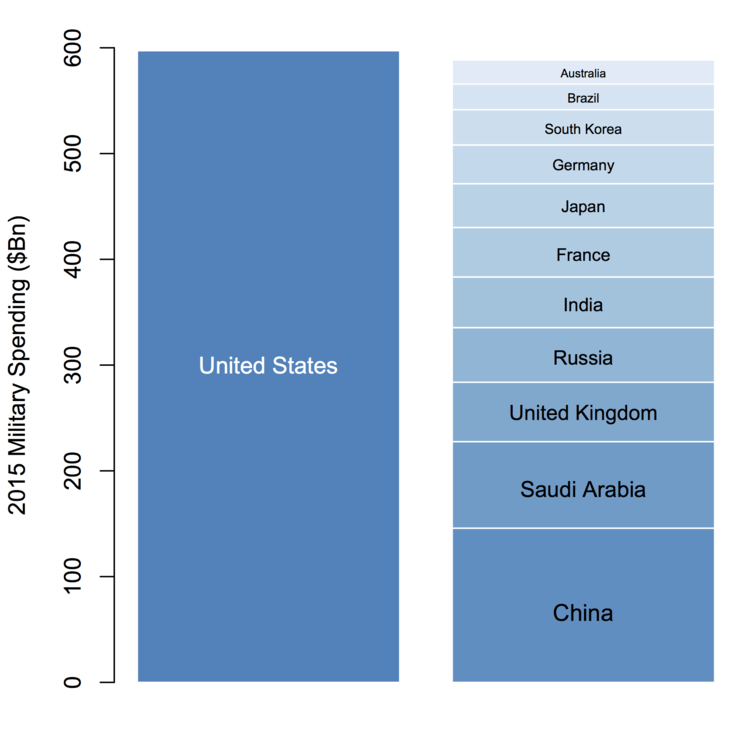Problems in the Numbers Game

The first major flaw concerns defense spending. Madson offers an infographic that shows a giant bar graph of American defense spending, followed by the next 7 to 11 countries combined (depending on which chart is used.) Yet the problem is that many countries likely misreport their spending. Just with China there is considerable evidence of cooking the books. Sinologist June Teufel Dryer for example estimates that Chinese spending is much higher based on several factors.[1] She points to complaints of province leaders feeding and housing soldiers to argue that the Chinese don’t report many of their personnel costs, such as housing and food. She argues that the cost of their nuclear weapons program, which is rather large, and the cost of their weapons acquisition programs are not included either.
The low range of the reconfigured Chinese budget is 30-40% higher than what the Chinese report. The high range of estimates would place their budget as much as ten times higher. The median derived by most analysts suggests a military budget three to four times their disclosed amount. Using the amount China admits to (144 billion in military spending in 2015) and then multiplying by 4 (the amount that most analysts suggest) would place China roughly equal with the US in spending. And considering the low cost of living, that money can sustain a much larger military than it can in the United States.
The Problem with Spending
More importantly, Madson’s arguments assume that threats are simply a function of math. As though there is some sort of theme park cut out with his hand out that says, your spending must be this high in order to be safe. If that were the case then mathematicians and accountants would be the generals. More important than just the amount of money spent, is how the money is spent, the way soldiers and systems are deployed, and then the way they are led in combat.
Military analysts contend that America doesn’t need more spending that what it does not to meet its threats. They simply have to better use what they currently have and spend. For example, since we already mentioned China, America regularly conducts Freedom of Navigation patrols in the South China Sea. These stress the importance of international law which is needed to counter the use of brute force to seize disputed territory. American forces have upgraded their anti-missile defense by doing such things as upgrading the radar on Aegis ships, and networking the advanced sensors on the F35 with anti-missile firing platforms. Yet to meet the threats from China the air and naval bases needs more built in resiliency. This means they need repair kits, bomb shelters and redundant communication systems. The ships need better close in defenses such as rail guns. (Not to mention they could probably use some remedial courses in how to steer.)
Both of these are necessary to counter a Chinese strategy that relies on hundreds and even thousands of missiles, some of which that can hit Guam. In the event of war China is expected to launch these missiles at key elements of U.S. expeditionary forces such as airfields, ports, logistics hubs, and carrier strike groups. Without the built in resiliency the US forces could be paralyzed and denied access to Taiwan, the South China Sea, or disputed islands around Japan. China would then have a free hand in seizing key territory in what they call the “first island chain.” If successful, by the time American forces recover from the missile barrage, China would have seized the territory they wanted, and could present the world with a fait accompli similar to Russia’s annexation of Crimea.
Speaking of Russia, the geography of the Baltic members of NATO places the US in a similar problem of seizing key territory before America can properly respond. In extensive war games RAND concluded that Russia could field as many as 25 battalions within 10 days of the start of hostilities, compared to 17 for NATO. That doesn’t sound like an insurmountable difference, especially with NATO’s advantage in airpower. Using Madson’s logic then, we are wastefully spending more money than we need to. Except that current NATO forces are overwhelmingly light and would be overwhelmed by concentrated Russian artillery, missiles, and armored units. In the same war games analysts concluded that the Russians would capture Riga, the capital of Latvia, within 48-60 hours after invading.
To counter this, analysts have suggested pre supplied and forward deployed heavy battalions in the region. The armored brigades don’t represent many more soldiers than are already deployed in the region, but they will provide the key elements that force Russian heavy units to slow their advance, get off roads, and concentrate for battle, and essentially make them better targets for NATO air power. I asked over a year ago if the current NATO brigades in the Baltics are just a speed bump, and without critical adjustments that largely don’t involve money, but just a repositioning of forces and systems already in the area, they will remain that way.
This is getting a bit detailed, but I wanted to show the reader that matters of budget, strategy, and force structure matter just as much, if not more than simple screeds against spending money. The US faces real threats from a resurgent and aggressive China and Russia. Both of whom often cook the books to distort their massive military spending, and which have upgraded key forces such as missile technology that can stun the US into inaction through a massive surprise attack.
Problems with Morality
So far, I’ve shown how numbers are not a simple measure of threat. Countries like China cook the books and allies cut their military budgets to spend on social programs, which both distort the relative amount of spending. But spending money takes away from valuable social programs that help lives when the military just take lives. According to Madsen, we’ve been terrorists nonstop since 9/11. There is significant debate about the efficacy of social programs and their solvency, and perhaps I’ll address that in another post, but here I want to discuss the misuse of the word terrorist, and offer a brief word concerning morality in warfare.

I discussed this in far more detail back during the Bundy fiasco. But the short version is that terrorism is used far more for its pejorative and emotional value than its clinical description. Its very popular to repeat the cliché that one man’s terrorist is another man’s freedom fighter. In the sense that words themselves are weapons, this is entirely true. Various revolutionary groups, terrorists, and the governments that oppose them can use the terms to either bolster their position or undermine their opponents.
Yet, despite the manipulation of words, and despite some of the disputes over the definition of terrorism, it’s still entirely possible to tell the difference between a freedom fighter and a terrorist. Items such as the donning of uniforms, discrimination between military and nonmilitary targets, discernment against or deliberate targeting of civilians, and declarations of war from recognized heads of state, makes it very easy to distinguish between George Washington and Abu Al Baghdadi. There is some overlap between insurgents and terrorism, but its not nearly so indistinguishable as the purveyors of the cliché would lead you to believe.
Manson had a cult of personality that viciously and randomly stabbed people, including a pregnant women, while walking on the street. A soldier, wearing a uniform, in a constitutionally declared war is ordered into combat against other soldiers. This makes the morality of killing far different between the two. Even saying that, America rains death from above which is still horrible right? Yet killing a civilian by accident is different than deliberately targeting him or her. If they happen in the course of legitimate acts of war and the direct intention is a morally acceptable military target, then unintentionally killing civilians is within the realm of just war. That is still tragic and a horrible loss of life, but not a war crime or terrorism.[2] The public could reasonably ask if the military should have been more cautious, and used better judgement (not to mention aim) during the situation. But the military already works hard to have precision weapons that only hit their intended target, they assess targets and before they bomb in built up urban areas (such as the recent Battle for Mosul) they assess potential civilian loss. Even after all of these precautions, civilian lives are lost which doesn’t make it terrorism.
To make matters even more difficult, ISIS and other groups deliberately cloud the situation by militarizing nonmilitary targets such as hospitals and schools, and then trying to shield military targets with civilians. (The deaths of civilians in the latter case would be a war crime on the part of those using the human shields.)[3] This complication makes it more than “the US is evil for killing civilians or bombing a hospital,” because bad actors deliberately muddle the distinctions between acceptable and unacceptable targets. Moreover, like the hands up, don’t shoot narrative, (which was the lie of the year,) the supposed victims of these air strikes wale to the nearest reporter with an often tendentious narrative, which is then tabulated by anti-American NGOs and repeated by people like Madson.
In short, the context of fighting a war makes American actions legal, civilian losses are strenuously avoided, but often accidentally happen; despite being unintentional consequences of just warfare they are often exaggerated by American enemies to anti-American sources by the very people who criminally muddled the distinction between military and nonmilitary targets and put civilians in harm in the first place. Madson magnifies rare American misdemeanors and ignores the frequent felonies from bad actors.
Conclusion
I’ve provided a sober assessment of the American budget, disposition of forces, and morality of warfare (as well as my pet peeve when people misuse terrorism.) I did go into a bit of detail and couldn’t cover many other items. But I hoped that I showed that these are complex issues that deserve more than shrill moral condemnation.
China and others cooks the books to make American military spending look overwhelming. Even if it was, money spent is not the entire sum of threats faced, but based on particular circumstances and the US faces real challenges. American forces fight justly within recognized rules of war and seek to avoid civilian casualties against a barbaric enemy that deliberately kills, rapes, and uses civilians as shields in pursuit of their savage world view. Instead of Master’s of War, his post is more like some $hoveling Non-cents.
[Thanks for reading. I work as a freelance writer so if you found value in this work please consider donating using the pay pal button at the bottom of the page.]
********
[1] June Teufel Dryer, Recent Developments in the Chinese Military,” A Military History of China, David Graff, Robin Higham eds, (New York: Westview Press, 2002), 285-302.
[2] Michael Walzer, Just and Unjust Wars, 153-155.
[3] Gary Solis, The Law of Armed Conflict: International Humanitarian Law in War, 320. “If civilian casualties result from an illegal attempt to shield a legitimate military objective with a human shield, those casualties are the responsibility of the side using the human shield.”
No comments:
Post a Comment